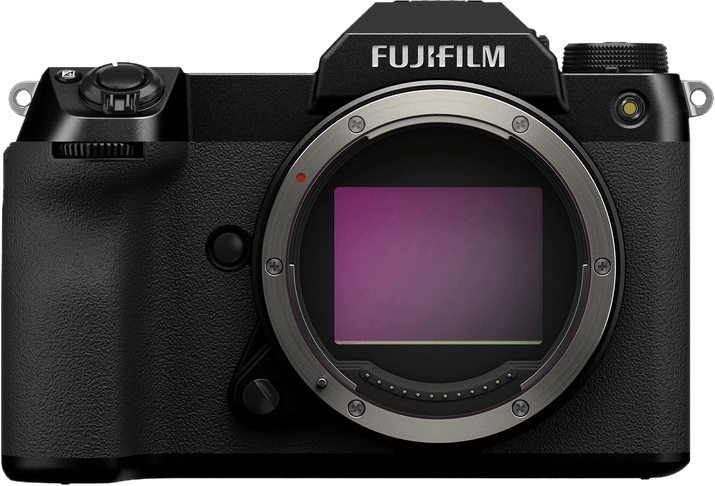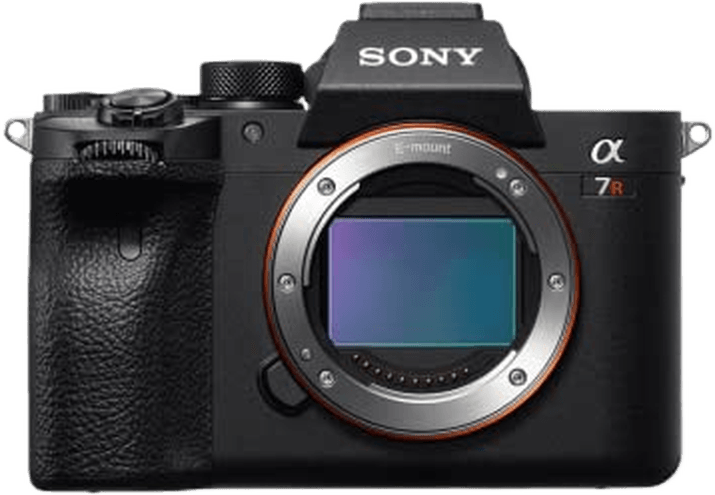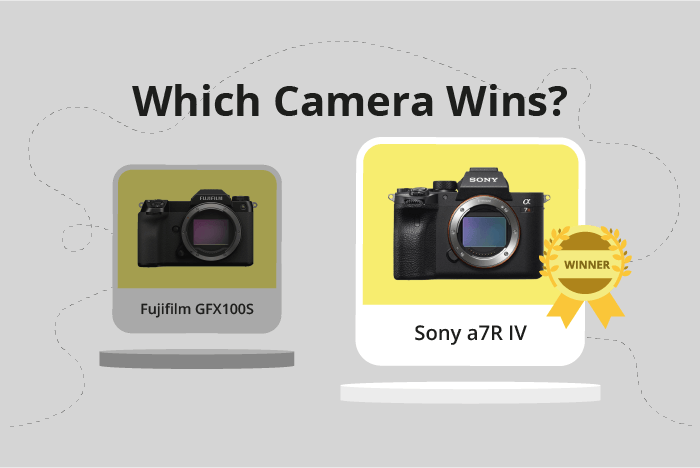Fujifilm GFX100S vs Sony a7R IV Comparison
Fujifilm GFX100S

Sony a7R IV

The Sony a7R IV outperforms the Fujifilm GFX100S with a score of 84/100 compared to 80/100. Both cameras are mirrorless and were released within two years of each other: the GFX100S in 2021 and the a7R IV in 2019. They share similarities in design, but the GFX100S is larger and heavier, measuring 150 x 104 x 87mm and weighing 900g, while the a7R IV is 129 x 96 x 78mm and weighs 665g.
The Fujifilm GFX100S offers superior image quality, thanks to its higher launch price of $5999. However, the Sony a7R IV has a more affordable launch price of $3500, making it an attractive option for budget-conscious photographers.
Taking all factors into account, the Sony a7R IV is the better choice for those seeking a balance between price and performance, while the Fujifilm GFX100S is ideal for professionals who prioritize image quality and are willing to invest in a more expensive camera.
Fujifilm GFX100S vs Sony a7R IV Overview and Optics
The Sony a7R IV outperforms the Fujifilm GFX100S in optics with a score of 85/100, compared to the GFX100S’s 78/100. Both cameras share several common specifications, including a CMOS sensor, image stabilization, and a similar processor (Bionz X for the Sony a7R IV and X-Processor 4 for the GFX100S). Despite these similarities, each camera has its unique strengths and weaknesses.
The Sony a7R IV boasts a higher optics score, mainly due to its faster shooting speed of 10 frames per second, compared to the GFX100S’s 5 frames per second. This makes the Sony a7R IV more suitable for capturing fast-moving subjects. Additionally, the Sony a7R IV has a DXOMARK sensor score of 99, providing a reliable benchmark for its image quality. The GFX100S does not have a DXOMARK score, as DXOMARK does not score Fujifilm cameras.
On the other hand, the Fujifilm GFX100S has a higher megapixel count at 102, compared to the Sony a7R IV’s 61.2. This gives the GFX100S an advantage in capturing more detail and producing larger prints. Furthermore, the GFX100S has a medium format sensor, which generally provides better image quality and dynamic range than the full-frame sensor found in the Sony a7R IV. The GFX100S also has a 4:3 aspect ratio, which can be preferable for certain types of photography.
In comparing the optics of these two cameras, the Sony a7R IV is the winner, offering a faster shooting speed and a proven DXOMARK sensor score. However, the Fujifilm GFX100S has its advantages, such as a higher megapixel count and a medium format sensor. Depending on the specific needs and preferences of the photographer, each camera can provide distinct benefits.
Fujifilm GFX100S vs Sony a7R IV Video Performance
The Fujifilm GFX100S outperforms the Sony a7R IV in video capabilities, with a video score of 83/100 compared to the Sony’s 70/100. Both cameras share some common specifications, such as 4K max video resolution and built-in time-lapse functionality.
The GFX100S surpasses the a7R IV in several aspects. It boasts a higher max video dimension of 4096 x 2160, compared to the a7R IV’s 3840 x 2160. Additionally, the GFX100S offers a max video frame rate of 60fps, which is double the a7R IV’s 30fps. This difference in frame rate allows the GFX100S to capture smoother and more detailed footage, making it a stronger choice for video enthusiasts and professionals alike.
On the other hand, the Sony a7R IV, while scoring lower in video capabilities, still provides respectable performance. It shares the same 4K max video resolution as the GFX100S and has built-in time-lapse functionality. While it may not be as powerful as the GFX100S in terms of video features, it remains a viable option for those who do not require the highest level of video performance.
In comparing the video capabilities of the Fujifilm GFX100S and the Sony a7R IV, the GFX100S emerges as the superior choice due to its higher max video dimensions and faster frame rate. However, the Sony a7R IV still holds its own with a solid 4K video resolution and time-lapse functionality. Ultimately, the decision between the two cameras will depend on the user’s specific needs and preferences in video performance.
Fujifilm GFX100S vs Sony a7R IV Features and Benefits
The Fujifilm GFX100S outperforms the Sony a7R IV in features with a score of 87/100 compared to 83/100. Both cameras share several specifications, including a touchscreen, flip screen, absence of GPS, and the presence of WIFI and Bluetooth connectivity.
The Fujifilm GFX100S excels with its larger screen size of 3.2 inches and a higher screen resolution of 2,360,000 dots, providing a clearer and more detailed image preview. This advantage enhances the user experience, especially when composing shots and reviewing images.
On the other hand, the Sony a7R IV holds its ground with a slightly smaller screen size of 3 inches and a lower screen resolution of 1,440,000 dots. While this may be a disadvantage compared to the Fujifilm GFX100S, the Sony a7R IV still offers a high-quality display and a user-friendly interface.
In terms of features, the Fujifilm GFX100S emerges as the superior camera due to its larger screen size and higher screen resolution. The Sony a7R IV, while not as advanced in these aspects, remains a strong contender with its competitive display and shared specifications with the Fujifilm GFX100S.
Ultimately, the choice between these two cameras comes down to individual preference and specific needs. The Fujifilm GFX100S offers a more advanced display, while the Sony a7R IV provides a slightly more compact option with a still impressive display. Both cameras excel in their respective feature sets, making them exceptional choices for any photographer.
Fujifilm GFX100S vs Sony a7R IV Storage and Battery
The Sony a7R IV outperforms the Fujifilm GFX100S in storage and battery with a score of 79/100 compared to 73/100. Both cameras share similarities in storage, including two memory card slots and compatibility with SD, SDHC, and SDXC cards (UHS-II compatible). They also both support USB charging.
The Sony a7R IV surpasses the Fujifilm GFX100S in battery life, offering 670 shots per charge compared to the GFX100S’s 480 shots. This advantage allows for extended shooting sessions without needing to replace or recharge the battery.
The Fujifilm GFX100S does not have any advantages in storage and battery over the Sony a7R IV. Its lower battery life is a drawback for those who require longer shooting times.
Considering the storage and battery aspects, the Sony a7R IV is the better choice due to its longer battery life. This feature ensures photographers can capture more images without worrying about battery depletion.
Alternatives to the Fujifilm GFX100S and Sony a7R IV
Are you still undecided about which camera is right for you? Have a look at these popular comparisons that feature the Fujifilm GFX100S or the Sony a7R IV:

